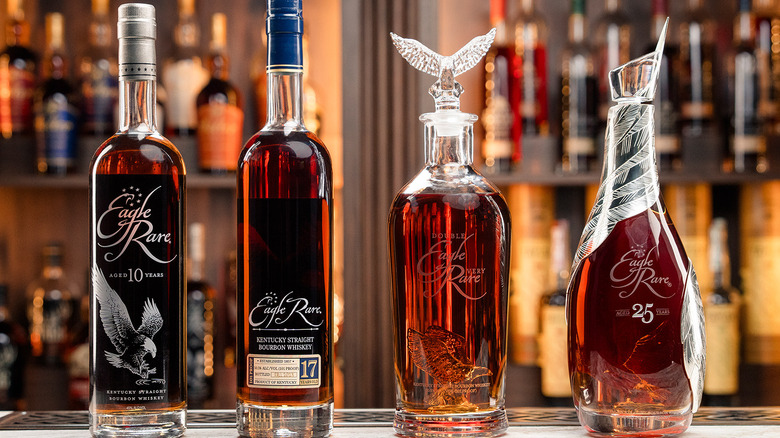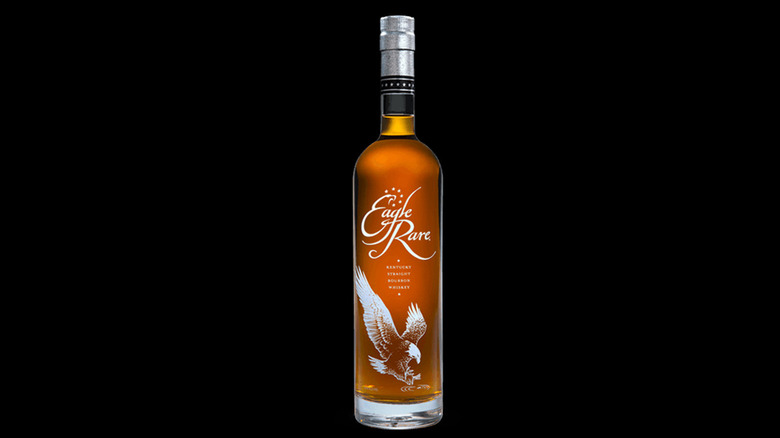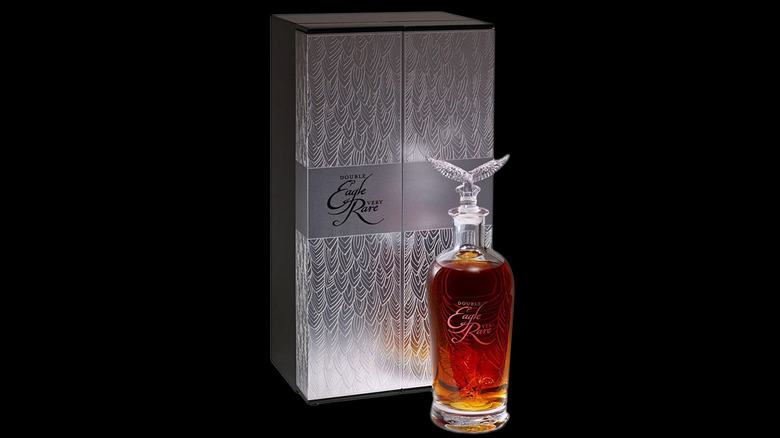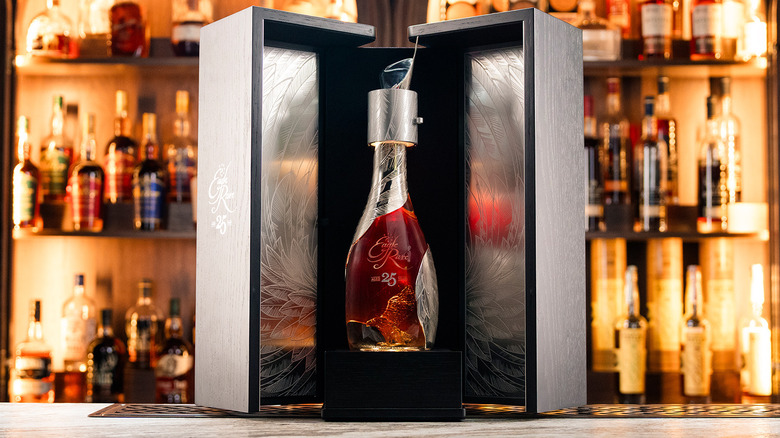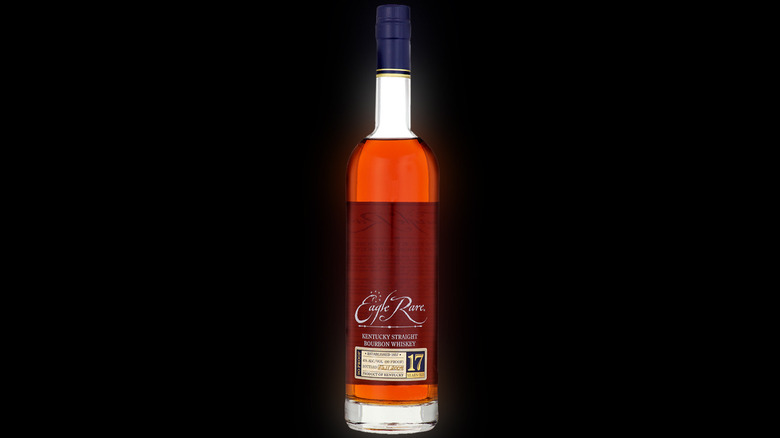Every Expression Of Eagle Rare Bourbon, Ranked
Buffalo Trace has formally announced a breakthrough expression of its coveted Eagle Rare bourbon. This new expression, aged 25 years, debuted on the 25th of October on 25th Street at 11 Madison Park (in the Michelin-starred restaurant's 25th year). Tasting Table was lucky enough to try the new ultra-luxe Eagle Rare 25-Year twice while hearing the backstory of its production from Master Distiller Harlen Wheatley. In addition to sampling this special expression of Eagle Rare, we were also privy to tasting the entire Eagle Rare line-up. This allowed us to base our rankings strictly on first-hand experience.
Typically, the early 20s is the top age that bourbon seems able to achieve, at least in Kentucky climes. That was until recently when Buffalo Trace applied all of its findings to change that. An age statement often correlates to a better whiskey, but that's not a hard rule. A younger whiskey may turn out better simply because of its resting location and aging conditions. We took the age of the bourbon into account but also ranked on traditional tasting factors: nose, taste, and finish were all considered.
Eagle Rare is produced in tightly controlled settings, under similar conditions and the auspices of very knowledgeable whiskey-makers. It's seen the recent release of the 20-year-old Double Eagle Very Rare and the launch of the still fairly new Buffalo Trace Antique Collection Eagle Rare 17-Year. We know that, given time, the 25 won't be the oldest Eagle Rare ever seen, but is it the best?
4. Eagle Rare 10
Here's the deal: Taken in order of age progressions, there are three pairs. Eagle Rare 10 and 17 have a better flavor. The 17-year and 20-year have more depth. The 20 and 25-year manage to tame a lot of the astringency from the tannins, as well as temper the kick. So while a greater age indicates more success in that it's incredibly difficult to bring bourbon to year 25 successfully (and actually improve upon some undesirable characteristics that emerged in a younger one) — in a blind test, you just might be surprised to find there's no need to keep improving on success.
And boy, is it ever! Oh, what a nose! Candy, honey, lusciousness. A wonderful whiskey, full of promise. At first taste, the base Eagle Rare is smooth, then lemony, with a crackling finish that brings up oak and cacao. Add a drop of water, and it changes quite a bit to include mango or a more pungent peach. Tutti-frutti, even. (Others have remarked on this "Juicy Fruit" gum quality as well.) Sweet and earthy, its nose now contains a bit more rosewater. On the finish, maple syrup comes up. Eagle Rare is such a fantastic bourbon, just a terrific expression of the Mash Bill #1. Its downside is that it can be really tricky to find, especially considering that it's well-priced for the returns.
3. Double Eagle Very Rare
To be honest, we preferred Eagle Rare to Double Eagle Very Rare by a hair, but we're not out here to tank these rankings based entirely on personal preference. No, the broader wisdom separates these two by flavor and then again price differential (of which there is a staggering magnitude). We defer to common sense by giving the slight edge to the unbelievably pricier bourbon, but if it's our money on the bar, we think Eagle Rare delivers most of the joy from Double Eagle for a sliver of the price. So: to the tasting.
Double Eagle Very Rare's gold color leaves tightly clustered legs that fall slowly and erratically. It looks mostly similar in shade to the 25, so whatever visual changes it goes through are set more firmly in later years. The nose is milder than the younger 17, which is surprising. There's vanilla and brown sugar. The taste is pretty much wood polish before it dives into oak and rye, so it's the most straightforward in the lineup. Like the 17, this is a 101 proof. It gets better with a drop of water, although retains a stark bourbon kick, and so might only be preferred by those looking for a bite. It's a niché characteristic for the cost.
2. Eagle Rare 25
Well, here we are, the big one. One of just a few bourbons to breach the quarter-century limit and likely the first by inevitable design rather than careful coaching into geriatric longevity. It's slightly redder than the 20-year Eagle Rare expression, but not by much. As with most of this line-up, it's 101 proof.
The aroma is all Fruit Loops: corn, and berries, and citrus. Surprisingly that's not in the taste, which is caramel, and only gives up a little strawberry on the chew. At the finish, it's a bit more savory, but only at the end of the end.
Keeping with the theme of this version of the bourbon, it gets fruitier with a drop of water. It's interesting, for sure, but it doesn't appear to have added an immense amount more of this than the 20-year Double Eagle. What is weird and intriguing is how Wheatley and his team were able to reduce the astringency with even more time in the barrel. It has a better taste amid a diminished bite, but it's hard to say it's worth an extra five years' push to arrive here, other than proving what can be done in controlled climates. But this version, at least, doesn't attain the heights of its junior counterpart, the best Eagle Rare expression.
1. Eagle Rare 17
We loved Eagle Rare 17 in our 2022 ranking of the Buffalo Trace Antique Collection, where that fruity earthiness was prevalent. This year's edition saw the 2023 Eagle Rare 17 climb up to 19 years (though still age-stated at 17 minimum) and higher while also ascending to the top of our tasting. It remains so here.
Without even consulting our notes, we came at this one cold and found it added butterscotch, cut grass, and strawberry to the aroma when compared simultaneously with the 10-year. The 17 has the best nose of the Eagle Rare family, and its taste has a great depth that doesn't descend too much into astringency or too mild into reclaimed nuttiness.
On the tail, there's oak, acetone, and pepper. Add a drop of water, and it's basically the same, but more honey comes to the fore. We even think 10 has the better finish, but overall, the 17-year expression is the best Eagle Rare. Keep in mind that when parsing between such a stellar selection, success in the race mostly depends on how you prefer certain characteristics. That's cold comfort for those likely to see only one or two of these rare bottles at their liquor store or bar, priced somewhere around the cost of a new Playstation 5. At least we can afford Daniel Weller.
